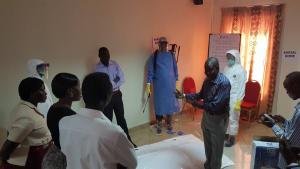South Sudan investigates the suspected Viral Haemorrhagic Fever outbreak in Yirol East, Eastern Lakes State
Juba, 10 January 2018 – Following a report of suspected viral haemorrhagic fever (VHF) outbreak in Thonabutkok village, Yirol East County on 28 December 2017, a multi-sectoral response in the context of one health was launched by the Ministry of Health, WHO and other experts from the human and animal health for an in-depth investigation to establish the cause of deaths in three people as well as reported deaths and abortions in domestic animals and wild birds.
The team followed up close contacts of the three deaths and monitored them for any signs and symptoms of VHF. So far no close contacts on follow-up have developed any symptoms. In addition blood samples were drawn from humans and animals to analyse the possible causes of the suspected VHF outbreak.
Thanks to the swift multi-sectoral response to this outbreak, the Polymerase Chain Reaction (PCR) laboratory investigations have revealed that all the seven samples from the humans have tested negative for VHF including Ebola, Marburg, Crimean-Congo Haemorrhagic Fever, Rift Valley Fever and Sosuga viruses, says Dr Argata Guracha, the Officer in Charge for WHO South Sudan.
The Ministry of Health with support from WHO and partners continued to investigate and monitor the situation at all levels, says Dr Guracha. In light of the increasing risk of emerging and re-emerging disease outbreaks and epidemics, WHO with funding from the United States Agency for International Development (USAID), the EU Humanitarian Aid and the Government of Japan, strengthened epidemic preparedness and response through building the capacity of multidisciplinary experts drawn from line ministries and partners to respond to such events, Dr Guracha emphasized.
To strengthen animal and public health surveillance, WHO supported the deployment of an additional team from the National Ministry of Health, Ministry of Livestock and Fisheries to coordinate, monitor and supervise the response in Yirol East county. In addition, over 30 frontline health care workers were trained in case management and infection prevention and control (IPC). WHO also prepositioned medical supplies and personal protective equipment (PPE) to support the response.
Besides, public awareness has been heightened to ensure that any person who has fever and bleeding and two or more other symptoms such as headache, vomiting and joint pains is immediately reported to the health facilities. Any deaths of people who developed high fever and bleeding should also be reported quickly to health authorities.
Haemorrhagic illness can be caused by a wide range of diseases – including Rift Valley Fever, Crimean- Congo Hemorrhagic Fever, dengue, as well as Lassa fever and Marburg.
Email: guyoa [at] who.int (guyoa[at]who[dot]int)
Tel : +211923362401
Email: wamalaj [at] who.int (wamalaj[at]who[dot]int)
Communications Officer
WHO Rwanda
Mobile: +250 795 450 856
Email: ebrahimj [at] who.int (ebrahimj[at]who[dot]int)



